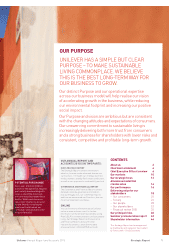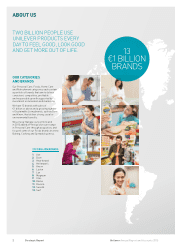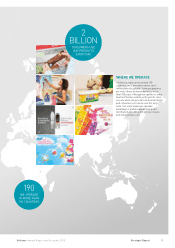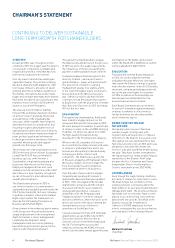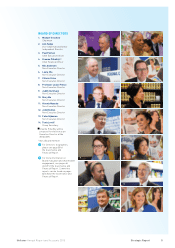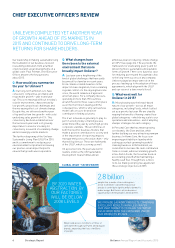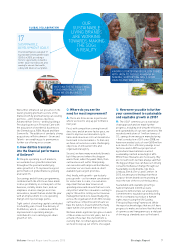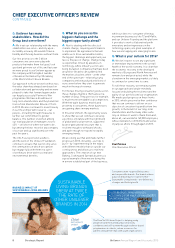Unilever 2015 Annual Report Download - page 14
Download and view the complete annual report
Please find page 14 of the 2015 Unilever annual report below. You can navigate through the pages in the report by either clicking on the pages listed below, or by using the keyword search tool below to find specific information within the annual report.
EMERIN SOIAL TRENDS
FM companes are among the frst
to experence and be affected by today’s
rapdly changng tastes, socal norms,
populaton shfts and wealth dstrbuton
The world’s economc centre of gravty
s movng to the southern and eastern
hemspheres By 2025 almost half of
Fortune 500 global companes wll be
from emergng markets
These trends drve urbansaton In 2010
there were 27 ctes of more than 10 mllon
people By 2030 t s expected that there wll
be 41 In turn, emergng market consumers
are ncreasngly demandng product
standards common n the West where
premumsaton s a domnant trend
The West retans strong economc
opportuntes but wage growth s
stubbornly low and unemployment hgh,
reachng 20% among Eurozone youth
Although blateral trade deals contnue,
these conflctng pressures are leadng
to some sgns of protectonsm
The world s gettng older wth dependency
rates rsng Between 2015 and 2050, the
proporton of the world’s populaton aged
over 60 wll nearly double from 12% to 22%
and n hna alone there wll be 330 mllon
people over the age of 65 by 2050 compared
wth 110 mllon today
At the same tme, younger generatons of
mllennals (18 to 34 year-olds) have new
expectatons, from authentcty and qualty
of products to standards of corporate
behavour Ther work, shoppng, lesure
and meda habts are radcally dfferent
Such change mrrors socal upheaval
wth socetes becomng more complex,
accommodatng rapdly changng ways of
lvng In London, 300 languages are spoken
and, n the UK as a whole, almost a thrd of
households are sngle occupancy Forced
and voluntary mgraton s happenng on
a scale not seen snce World War II
Other new economc forces are emergng
By 2030, 27% of the world’s 83 bllon
populaton wll be Muslm compared wth
23% n 2010 Women are an ncreasng
force for change In Latn Amerca the
labour partcpaton rate for workng-age
females clmbed from 53% n 1992 to 65%
two decades later
But pressures reman Inequalty s
wdenng, wth the 80 rchest people havng
a combned wealth equal to the poorest
35 bllon The envronment s under
ncreasng stress, demandng a greater
response from people and companes The
World Health Organzaton estmates that
7 mllon people de from ar polluton each
year Ice caps are meltng at 12% a decade,
whch means global warmng and drought
wth profound mplcatons for the FM
sector Wth the exstng clmate change
scenaro, almost half the world’s populaton
wll be lvng n areas of hgh water-stress
by 2030
OMPETITION
The FM ndustry s charactersed
by global competton between large
multnatonal corporatons seekng to
dfferentate themselves n the eyes of
consumers whle accessng markets
through smlar channels Some of the
largest FM companes competng
alongsde Unlever nclude Nestlé,
Procter & amble, L’Oréal, Danone,
KraftHenz and olgate-Palmolve
Many have dentfed emergng markets
as a maor growth opportunty n the
years to come
ompetton contnues unabated In 2015
one notable trend n certan parts of the
FM sector, manly n foods n the
slower-growth developed markets, was
consoldaton often drven by prvate
equty nvestment actvty
There has also been sgnfcant
deconstructon and refocusng wth
compettors sellng brand portfolos
to acheve effcency gans
Local compettors reman a vbrant
presence wth nnovatons and consumer
offers to rval those of global players
Among customers, the relatve declne of
supermarkets contnues n favour of local
and convenence stores, dscount chans
– often wth own label offers – and
e-commerce
For companes operatng n the
FM ndustry the queston of what
a household s n today’s socety s a
crtcal one Our products are household
goods so changes n what households
demand, and why, have an mportant
mpact on our busness We are seeng
rapd change n the concept of the
household, whch has become more
dverse and unconventonal over the
past 50 years
Ths s reflected n more flud famly
roles and responsbltes wthn
households as the workng patterns
and denttes of prncpal ncome earners
change The number of households s also
ncreasng rapdly as more people lve on
ther own or n smaller famly unts Sngle
occupant households have rsen to 175%
worldwde and 33% n Western Europe
The change n the nature of households
s lnked to the changng role that women
are playng n socetes around the world
For many large FM companes, women
consttute the maorty of the customer
base and ther purchasng decsons are
therefore crtcal to the ndustry’s
development There has been rapd
175%
Sngle occupant households
have rsen to 175% worldwde
HOUSEHOLDS ARE HANIN
growth n educatonal attanment by
women where, n many countres, they
make up more than 50% of graduates
Ths has not yet, however, translated
nto greater labour market partcpaton,
better pay or more executve roles
However, the trends n our markets
suggest ths s changng and wll do
so at an ncreasng pace
11Unilever Annual Report and Accounts 2015 Strategic Report


